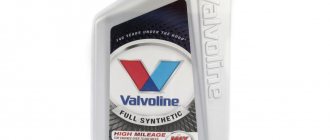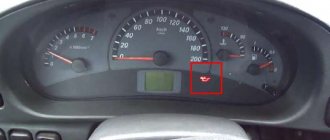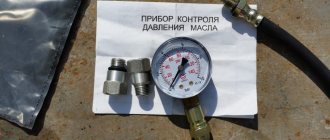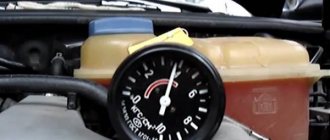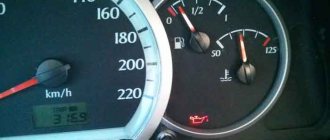One of the parameters of engine operation is oil pressure. To ensure uninterrupted and high-quality functionality of the power unit, each driver must constantly monitor the maintenance of the required oil level in the engine. If the oil pressure light comes on on the dashboard of a VAZ 2114/2115, you must immediately take some action. The indicator will light up in cases where there are certain problems with the oil pressure in the engine unit system.
What does the lamp indicate?
The indicator light on the dashboard reacts strictly to engine oil pressure. Due to the level being reduced within reasonable limits, the signal will not appear on the panel. The exception is the loss of 2/3 of the lubricant when the oil intake of the pump begins to pick up air and crankcase gases. Then the pressure in the lubricating channels will inevitably drop, to which the sensor will react and the light will light up.
The oil receiver is specially installed at the bottom of the pan so that the system operates when there is a lack of lubrication
The circuit, signaling problems with lubrication of the power unit, consists of parts that also periodically break. So a flashing lamp does not always mean fatal engine failure. But if it lights up on your car, then you need to act like this:
- Stop moving.
- Turn off the engine.
- Check the lubricant level and, if necessary, add up to normal. The lubricant level in the car engine is checked with a special dipstick
- Topping up did not work - transport the car to the garage or to a car service using a tow truck or in tow.
- If the indicator light is intermittent (flashing), then move to the repair site under your own power at low speed. Monitor the coolant temperature gauge and pressure light: when it stops flashing and lights up, immediately turn off the engine.
In your garage, you can find the cause of the alarm if you follow the steps below.
Replacing the coolant temperature sensor
The VAZ-2114 antifreeze temperature sensor itself is a thermistor (resistor) with variable resistance.
Its indicators change depending on the temperature:
- 0 degrees – 9420 Ohm;
- 20 – 2868;
- 25 – 2796;
- 30 – 1350-1880;
- 50 – 585-820;
- 70 – 280-390;
- 90 – 155-196;
- 100 – 177;
- 110 – 87-109.
It may fail for one of the following reasons:
- failure of electrical contact inside the controller;
- broken wires near the sensor;
- insulation violation.
- Cool the engine after driving and store the car in the garage. Prepare a set of tools and containers for the coolant; you will have to replace it. Ask a friend to help you to make your work more convenient and faster - you will need to drain the antifreeze from two units.
- Remove the engine protection and remove the radiator mounts.
- Turn the heater to maximum, open the expansion tank cap and the heater tap.
- Place a container under the radiator and slowly begin to unscrew the plug to drain the antifreeze. If you move too quickly, excessive pressure will build up, which will force coolant out of the expansion tank.
- It will take you about 10 minutes to remove all the liquid. While this process is taking place, place the container under the engine and find the plug on the cylinder block, it is located next to the ignition module. Also wait 10 minutes.
- Find the sensor between the cylinder head and the thermostat; it looks like a hexagon. Remember its position or mark it so that you can install the new one as well. Unscrew the sensor with a 21 key.
Before installing a new sensor, apply a small amount of heat sealant to the threads.
Install the new controller in place of the old one so that it stands on the same marks, pay attention to the position of the marking of this element. After this, you need to tighten the plugs and pour new coolant into the cylinder block and expansion tank
Oil pressure light comes on at idle, check methods
Now let's talk about the case when the low oil pressure warning light comes on while the engine is idling. Below we present available methods for identifying malfunctions, which will generally be useful in diagnosing the condition of the engine lubrication system and engine oil pressure.
- If the oil pressure light comes on, then you should check the engine oil level in the engine and its condition. If the level drops, add oil. A suspicious condition of the oil (black color, excessive thickness) will require thorough flushing of the oil system and subsequent oil change. The smell of gasoline/diesel, emulsion on the oil filler cap, or severe dilution of the engine oil will indicate problems with or cracks. On a working engine, the combustion chambers should be sealed, fuel and antifreeze should not enter the lubrication system.
- The oil pressure lamp may come on at idle immediately after changing the oil during the first start. In this case, the warning light may remain on for 10, 15 or even 20 seconds. If after the specified period of time the low oil pressure lamp does not go out, then you should check the oil filter. The product may be of poor quality, poorly screwed (oil leaks are noticeable in the area where the filter is attached) or defective.
- Check the oil pressure sensor. The oil pressure level at idle speed at around 800 - 900 rpm should not be less than 0.5 kgf/cm2. It is also worth noting that emergency oil pressure sensors on different engines may have different response ranges, which on average range from 0.4 to 0.8 kgf/cm2. This means that if there is a sensor designed to operate at 0.7 kgf/cm2, already during a pressure drop to 0.6 kgf/cm2 the sensor will turn on the emergency oil pressure lamp. This is done for conditional notification of a decrease in pressure in the line of the internal combustion engine lubrication system.
The initial check of the sensor should be done by slightly increasing the crankshaft speed (1000-1100 rpm). In other words, if the oil pressure light goes out when you press the gas, then the following options are possible:
- idle speed is too low (the light blinks at idle);
- low oil pressure in the lubrication system;
- malfunction of the oil pressure sensor;
- engine malfunction;
To accurately measure the oil pressure in the engine, you need to unscrew the sensor and install a pressure gauge in its place. Also, one should not exclude false alarms of the oil pressure sensor at idle speed, which may occur due to contamination of both the device itself and the engine oil channels. In this case, you will need to clean the sensor and clean the lubrication system channels.
As for engine breakdowns that lead to a decrease in oil pressure, indirect signs are increased consumption of fuel and engine oil, the engine emits blue or bluish smoke. In such cases, the oil pressure lamp lights up at idle, taking into account the warmed-up engine. This occurs due to the fact that the heated lubricant liquefies and flows freely through the gaps between various parts (liners, shaft journals, etc.).
Another reason could be a malfunction of the oil pump itself. During engine operation, wear of the gear pair and the internal and external surfaces of the oil pump housing may occur. Let us add that engineers set the pump’s performance to be such that it initially allows you to create pressure higher than that recommended for the motor. It turns out that the pump always pumps oil “with a reserve”. In this case, the oil pump is driven from the crankshaft, that is, the oil pressure depends on the speed (crankshaft rotation speed).
As you know, at idle the crankshaft speed is minimal. At the same time, the oil pump also develops a minimum pressure. As a result, a relatively small deviation can lead to the oil pressure lamp coming on at idle, while when the speed rises and the oil pressure in the lubrication system increases, the problem of the low oil pressure warning lamp on the dashboard coming on may not appear.
Engine oil pressure: what it depends on, how to measure it correctly. What is the oil pressure on different engines in idle mode and under load.
Why there may be low oil pressure in the engine, the oil pressure light blinks at idle or under load. Fault diagnosis and repair.
Elimination methods
Now you can go directly to the elimination methods. First, you need to figure out what tools you may need to complete the process: a 10mm wrench, a multimeter, a set of screwdrivers. Now that everything is collected, you can move directly to solving problems.
Low oil level on dipstick
The dipstick is used to measure the oil level in the engine.
Oil production and wear can affect its level, so it is worth checking this indicator regularly.
Also, the cause of oil loss in the engine may be a faulty gasket or a breakdown in the engine crankcase . In order to eliminate oil loss, it was necessary to eliminate the malfunctions that caused the effect, and then add oil to the required level.
To measure the oil level, there is a special tool called an oil dipstick. It is located on the front of the engine. The oil level in the engine should be midway between the minimum and maximum indicators. When the indicator drops below the MIN mark, the oil level indicator lights up on the dashboard.
Sensor malfunction
A sensor malfunction can also cause an oil level indicator to appear on the dashboard. To eliminate the malfunction, you need to check the sensor, and if it is faulty, replace the part.
Old and new oil level sensor The replacement process is quite simple and not complicated. Let's consider the issue in more detail. To complete the operation, you will need a key for 10. So, let’s proceed directly to the sequence of actions aimed at replacing the sensor:
- The car must be installed so that there is access from below. A viewing hole, a lift or an overpass is suitable for this.
- Disconnect the negative terminal on the battery.
Remove the negative terminal from the battery. - If there is, it is necessary to remove the lower engine protection.
Remove the engine crankcase protection. - We dismantle the pallet.
You must first drain the oil from the engine through the drain plug. We dismantle the pallet. - Disconnect the wire block from the sensor. We clean the engine oil level sensor from dirt. Disconnect the block from the wires.
- Using a 10mm wrench or socket, unscrew the oil level sensor.
- We install a new sensor and carry out the necessary assembly.
Contact circuit problem
Diagnostics of the fuel level sensor chip More than once, the cause may be a break in the wires or contact group that goes from the sensor to the electronic control unit. Based on the electrical diagram of the car, we find the corresponding wire that powers the meter. Next, we find exactly the same one in the ECU and call it.
If there is no contact, then a break has occurred in this area and should be repaired. We carry out the same procedure with the remaining wires.
Short circuit inside the instrument panel
More than once, a short circuit inside the dashboard board can be the cause of a light on the dashboard. This may be caused by corrosion damage or a short circuit inside the instrument panel. Thus, the solution to the problem may be to repair the board or replace the instrument cluster.
Checking the contacts of the dashboard board It is quite easy to determine the malfunction: you just have to disassemble the device and look at the contact connections. Also, to be completely sure, you can ring the contacts on the board and directly on the indicator lamp itself, using a tester.
Malfunctions in the VAZ-2114 ECU
The last possible option to look for a fault is the electronic control unit. Errors may occur here that will not only cause the oil level light to light up, but also cause other indicators to malfunction, such as the speedometer, turn signal, and others.
The method of troubleshooting is to connect a laptop or tablet to the “brains” of the car via an OBD cable and a standard test. If errors related to the oil level are detected in the ECU, they must be reset. The procedure for resetting all errors should be done for all indicators that have accumulated in the “brains”. After this, the problem should disappear; if not, then the fault must be looked for elsewhere.
Main reasons
- Minimum oil level. Today this reason is considered one of the most common. When using the vehicle regularly, it is recommended to carefully monitor the oil level and try to notice various drips on the engine body. Any, even the smallest oil stains under the car are sufficient reason to check the oil system.
- Using bad filters. A certain amount of oil should always remain in the filter, regardless of the stop of the power unit. This is required so that the effect of “engine oil starvation” does not form. As practice shows, many low-quality filters do not retain oil, so it flows into the crankcase without any problems. The only way to cope with this situation is to replace the filter with a better one.
- Wiring fault. Very often the oil pressure light stays on for a long time due to wiring problems. It is located on the panel and connected to the sensor via a wire. If the oil pressure drops below a certain level, the sensor closes the light to ground. When the pressure becomes normal, the contacts open and the light goes out. However, if the sensor itself is broken, the light will not turn off. In this situation, it is necessary to conduct a thorough diagnosis, replace the wiring, as well as parts that have failed.
- Reducing valve failure. If the pressure level is minimal, then the working pressure relief valve will be located in the closed position. If it freezes or gets stuck in the open position, the required pressure will not be generated in the system, and accordingly, the light will be constantly on.
- The pump screen is clogged. It is this part that is responsible for effectively protecting the pump, as well as the power unit, from the penetration of all kinds of debris onto various surfaces. Hard chips, dirt, dust and other objects - all this has a negative impact on the surface of numerous parts. If the oil is clean, free of all kinds of contaminants, then it easily passes through the mesh. At this moment, the sensor is set to a “quiet state,” which confirms the normal functioning of the motor. However, when the oil becomes dirty and moves poorly through the filter, it is not possible to provide the required pressure. To solve this problem, it is necessary to replace the oil pan.
- Oil pump failure. If this device cannot guarantee the pressure necessary for high-quality lubrication, then the contacts are closed, accordingly, the light will constantly signal to the driver that there is a fairly serious malfunction in his vehicle.
If the pressure light is dim, you should check the wiring or replace the light bulb itself.
You can learn about the oil pressure in your car from the article What is the oil pressure.
Pinout of the VAZ-2114 window lifter button
If you look at both halves, into which the VAZ-2114 window lift button was disassembled, then two rows of contacts and sockets for them clearly appear. One has four elements, the other three. This missing contact is considered the starting point for the subsequent pinout of the VAZ-2114 window lifter button.
With half of the body facing towards you, the contacts are numbered. Each “tooth” corresponds to a wire of a different color.
- Yellow. It connects to the dimensions and serves as a “plus”.
- Black. You can connect it to the negative side of the battery or connect it to ground.
- Red. This is a nutritional plus. Can be connected to a battery. Then the VAZ-2114 window lifter will work both with the ignition on and not. If the driver wants to get a working mechanism only when the engine is started, it should be connected to a similar plus of another unit.
- Green. Output to window lift motor.
- Blue. Output to window lift motor. If the 4th and 5th nodes are swapped, the device will work. But instead of an up arrow, the glass will go down. And vice versa.
- The sixth and seventh ones are automatically connected by “mice” to black, that is, to ground. But some recommendations suggest that this action is not advisable. It is better to connect to the battery.
The fundamental difference between whether the contact is connected to a battery or to another source is that in the first option the mechanism will work even when the ignition is turned off. And the pinout in these cases is relative.
How does the oil pressure indicator work?
Controlling the pressure in the lubrication system is simple. A sensor is installed in one of the channels of the lubrication system that responds to changes in pressure. This sensor is connected by an electrical circuit to the warning light on the dashboard.
The operating principle of this scheme is also simple. If there is no pressure, the sensor closes the circuit, so when the ignition is turned on, the light comes on, indicating that the electrical circuit is working. After starting the engine, the oil pump pumps oil, so the pressure in the channels increases. When a certain value is reached, the sensor opens the circuit and the light goes out.
The sensor itself is set to the minimum pressure required for normal engine operation. This indicator differs on different models; on some engines the working indicator is 0.3 - 0.4 kgf/cm2 at idle, at speeds of 2000-3000 and more than 0.5-0.7 kgf/cm2.
When operating the machine, a problem arises when the pressure indicator lamp lights up while the engine is running, and its light may vary. For some, the control lights up at idle and the glow is dim, while for others the signal is bright and appears at medium and high speeds. If the lamp lights up at idle and goes out when driving, then you need to look for the cause.
And under whatever conditions the warning system is triggered, measures must be taken immediately. The lubrication system directly affects the performance of the engine and its malfunction will result in serious damage.
The first thing the driver should do when the lubrication pressure light comes on is to stop driving and turn off the engine. The next step is to identify the reason for the alert.
Mass fuel flow sensor
Mass air flow sensor is a very important element of any injection engine. It is a plastic structure with a platinum thread inside. When the ignition is turned on, a small voltage is applied to it, which increases the temperature due to the high resistance. When the engine starts, the incoming air cools it, which causes the resistance to change, and according to Ohm's law, this affects the voltage. All this data is collected by the controller and processed, making a conclusion about how much air passes through the mass air flow sensor.
If the sensor malfunctions, important readings stop coming or are given in an incorrect form, which is why the engine control unit switches it to emergency mode. In addition, there are a number of signs that indicate a malfunction:
- Poor dynamics;
- Long engine start;
- Increased fuel consumption;
- Unstable or “floating” speed;
Why does the oil pressure light come on in VAZ 21142115
There are several likely reasons why this car light suddenly comes on. And only based on an accurate determination of the cause can the necessary actions be taken to eliminate the malfunction.
The indicator may light up in two cases:
at engine idle speed;
when the car is moving.
Each of these cases has its own causes of malfunctions.
The light came on at idle
The oil pressure light may come on (or blink) at idle, and if you press the gas pedal, the icon will immediately go out. In this case, the most likely causes of malfunctions are the following:
the crankshaft liners are worn out: the oil pressure will drop due to the fact that the gap between the thinned liner and the car’s connecting rod has increased;
the oil receiver mesh is severely clogged: one of the most common reasons why a light bulb suddenly lights up. Various types of sediment are gradually deposited on the surface of the engine sump. At the moment when there are too many deposits, the pump can no longer supply enough oil to operate the engine;
wear or any problems in the oil pump: another probable reason why the indicator may light up on a VAZ 2114/2115. Due to a breakdown of the pump itself or any part of it, oil does not enter the engine in the required quantity;
the sensor is faulty: it is quite possible that the oil level and the engine itself fully meet their basic characteristics, and the problem lies in the sensor;
the wiring is shorted: problems in the car’s electronic system can also cause the engine oil supply system to not operate correctly.
The oil can indicator light came on while driving.
In cases where the oil pressure light suddenly comes on while the car is moving, it is advisable to stop immediately. Probably the following failure or breakdown occurred:
the oil level in the engine unit is below the Min mark;
the oil filter could be clogged - this leads to the fact that the pressure invariably decreases;
it's time to change the oil - in cases where the car owner does not replace the substance in the engine for a long time, it loses its working properties.
Why does the alarm sound?
The reasons why the VAZ 2114 oil pressure is on may be:
- Damage to the oil pressure sensor.
- A break in the wires connecting the pressure sensor to the electronic unit.
- Low oil level in the system.
- Oil pump failure.
- Oil filter clogged.
Of all the above reasons, the last two pose the greatest danger to the moving parts of the vehicle. If the DDM itself breaks down, the cause can be eliminated literally in a matter of minutes. In addition to the above malfunctions, in which the signal in the form of an oil can on the dashboard lights up constantly, there are situations when it lights up periodically, either lighting up or going out.
The reasons for this behavior of the indicator may be:
- clogged filter mesh on the oil intake of the pump, which leads to improper operation of the latter;
- oil filter clogged;
- low oil viscosity due to its wear (it was not replaced for a long time);
- low oil viscosity due to gasoline entering the crankcase;
- short circuit of the wires connecting the DDM with the indicator on the dashboard;
- wear of crankshaft bearings.
Consequences of untimely oil changes Elimination of these reasons will help to completely get rid of the blinking pressure sensor on the panel.
Video of oil pressure light blinking
I myself am an experienced motorist and I know when the oil pressure light starts blinking, it’s always not good. I'll list them point by point.
1) Excessive engine wear. This means that the engine has high output and the oil pressure is below normal levels. Usually happens after a long mileage of the engine. BUT I don’t have that much mileage, the car is only in its second year.
2) The oil is not suitable for the engine. It happens that the oil is not suitable for the engine. This happened on our “classic” VAZs when they filled in oil that was too “thin” for them. At idle speed when the engine warmed up, the lamp began to blink indicating that the pressure in the engine was not enough. You just need to change the oil. But I have the oil that the manufacturer himself recommends, and made under his supervision (GM oil).
GM oil
3) Insufficient oil level. Just pull out the oil dipstick and check the level. It should be at average and not higher than “maximum”. If the oil is above the maximum mark, then it needs to be removed; more details in the article - excess oil in the engine. If the oil level is below the level, simply add it up to the norm to avoid oil starvation of the engine.
normal level
BUT my oil is always fine, I check it every day.
4) The oil pressure sensor is faulty. The oil pressure sensor is malfunctioning and, even though the oil level and pressure are normal, it provides incorrect information to the vehicle’s instruments.
In general, after I arrived at the official station and showed the fault, I was advised to add some oil to the engine. I bought exactly the same oil as mine, but the situation did not improve, the lamp still blinked.
add oil
into the engine neck
Then they took my car to the station for detailed diagnostics.
An hour later (+ free car wash) it turned out that the oil pressure sensor had failed. I just felt better, because engine repair is very serious, and an oil sensor costs pennies. At VAZ, I changed it in half an hour. But then it turned out that the Chevrolet Aveo oil pressure sensor is located at the bottom and changing it is not so easy. Therefore, my car was left for four hours, I agreed to pick it up in the morning.
Error codes for the VDO combination on the instrument panel of the VAZ 2110
- If 0 remains, then there are no errors
- When 1 appears, it indicates a microprocessor malfunction
- Open circuit of the fuel level indicator sensor
- Error 4 - increased supply voltage of the on-board network over 16 Volts
- Error 8 - low voltage, less than 8 Volts
- In case of several malfunctions, a number may be issued simultaneously, which will be the sum of the above codes, for example 6 (2+4), 10 (2+8), 12 (4+8) or 14 (2+4+8)
To be honest, these fault codes are not particularly useful. If we compare it with the readings of special on-board computers, such as STAT, then there is, of course, tens of times more useful information and various data. But we’ll talk about this sometime in future articles.
My devices also turn off when you drive and there is some kind of sound, the fuel level also floats, they blow me exactly the same, nothing helped and I looked at the mass on the handbrake, also zero
On my instruments it shows 3456 on top and 78 on the bottom, what does this mean, please tell me
Engine 21124 16 valve
Hello ! Help with the problem, I came to the car yesterday, everything worked, before that I cleaned the injectors. The next day the car started up, but after running for 3-5 seconds it stalled and no more spark, no steering wheel sensor, changed it, then I relieve the pressure in the ramp and try to start it, it starts for 4 seconds and stalls. Where to dig?
Please tell me. I'm getting error 78. VAZ 21124 16v europanel 2007
Hello, my VAZ 10, 8 valves had error 14, I cleared it, do I need to go for diagnostics?
Hello, My VAZ 2110 car will not start. I barely started it with a tugboat, the idle doesn’t work and the throttle doesn’t work, but I need to rev it up, what should I do? Tell me. And error 8 shows how to find this malfunction.
VAZ 2112 16-valve, during self-diagnosis it displays error 818.2... help save what is being done)
Hello, the VAZ 2112 stopped starting, the on-board computer shows error 43210
Who can tell me what error number 8 is?
1 Microprocessor error 2 Fuel gauge sensor circuit error 4 High voltage 8 Low voltage 12 Indicator lamp diagnostic circuit faulty 13 No oxygen sensor/LAMDA probe signal 14 Coolant temperature sensor signal high 15 Coolant temperature sensor signal low 16 On-board voltage too high network 17 Low voltage on-board network 19 Incorrect crankshaft position sensor signal 21 High signal level of the throttle position sensor 22 Low level of the throttle position sensor signal 23 High level of the intake air temperature sensor signal 24 No signal from the vehicle speed sensor 25 Low level of the intake temperature sensor signal air 27 High signal level of the CO potentiometer 28 Low signal level of the CO potentiometer 33 High signal level of the mass air flow sensor For GM NIVA: High signal level of the absolute pressure sensor 34 Low signal level of the mass air flow sensor For GM NIVA: Low signal level of the absolute sensor pressure 35 Idle speed deviation 41 Incorrect phase sensor signal 42 Malfunction of the electronic ignition control circuit 43 Incorrect knock sensor signal 44 Lean mixture 45 Rich mixture 49 Vacuum loss diagnostics 51 EPROM error 52 RAM error 53 No CO potentiometer sensor signal For GM NIVA : increased voltage 54 No signal from the octane corrector sensor 55 Depletion at high engine load For GM NIVA: error in the electronic control unit 61 Degradation of the oxygen sensor/LAMDA probe
Errors persist until they are reset manually! Also mistakes add up! Those. If you have errors 8 and 14, the display will show error 22.
Please help, I stood there warming up for about five minutes, suddenly the car stalled, it started on its own, then, too, at first Troila played with rpms of 1000-1500 and stalled again, and as soon as you press the gas it immediately stalls
The crankshaft sensor or the crankshaft itself may also be the crankshaft gear
Hi, I do everything as in the video, but the diagnostics are not performed, it just switches the mileage to daily and that’s it.
Sergey, press this button on the panel and hold it while turning the ignition key, everything will show there
The role of the oil pressure indicator
The red light, marked on many cars with the image of an oil can, was added to the dashboard for a reason. It is connected to a common electrical circuit with a sensor mounted in one of the channels of the engine lubrication system. When the element detects a pressure drop below a critical level, the circuit closes and the lamp flashes red, informing the driver of an emergency malfunction.
The signal from the red lamp with the image of an oil can indicates a malfunction of the engine lubrication system
The purpose of the emergency lamp is to warn the car owner in time about the engine's oil starvation. If for various reasons it does not light up or the driver ignores the red “oil can” signal on the instrument panel, then the following consequences may occur:
- due to lack of lubrication, the crankshaft journals wear out, the sliding bearings (liners) may rotate and finally jam; As a result of oil starvation, wear appears on the crankshaft journals
- In the absence of oil, the piston skirts will overheat and expand in volume, leaving scratches and scuffs on the cylinder walls; A poorly lubricated piston heats up and leaves scuff marks on the cylinder wall
- the camshaft bearings located at the highest point of the engine will fail; Without lubrication, the camshaft bearings quickly fail
- the service life of the remaining rubbing parts will be sharply reduced.
Insufficient amount of lubricant or its absence in any case leads to breakdown and costly repair of the power unit. A timely signal on the dashboard will help avoid this.
The battery does not hold a charge
If the voltage at the terminals is less than 12.5 Volts, remove the battery for charging. After charging the battery to 12.7 V, leave it unused for 12-24 hours. Then check the voltage at the terminals or the density of the electrolyte. A working battery will not be discharged during such a period. The cause of the discharge could lie in overloading of power supplies by consumers, frequent short trips, or frost. There is a possibility that the generator is malfunctioning.
Find out the charging time of your battery
Buying a new battery before you are sure that the old one is unsuitable is irrational. But if you have a spare one and the ability to use a battery from another car, you can install it in place of yours while it is charging, and try to start the car and drive it for several kilometers.
If the light on the VAZ panel no longer lights up, the problem was a discharged battery. We are waiting for ours to charge. If it does not hold a charge, we buy a new one or, if we have the time, desire, and abilities, we restore the old one.
The system failure indicator is on
Almost every car owner has encountered a situation where the red lubricant pressure lamp on the instrument panel lights up. But not all drivers know what to do in such a case.
After all, the situation can occur at any moment - both while the vehicle is moving and at idle speed. Definitely, if this problem occurs, the car requires repair work.
There are many reasons for the occurrence of an indicator signal. The driver is recommended to adhere to a certain rule: you cannot continue driving if the indicator lights up.
Neglecting the recommendation can lead to irreversible consequences, namely major damage to the car. The optimal solution in this situation is to call a tow truck and go to a car service center to diagnose the control system.
Motor oil, in addition to its main function of lubrication, acts as a cooling agent. If the pressure in the power unit decreases, then, consequently, the temperature of the mating elements increases.
The motor begins to wear out, that is, under extreme operating conditions. It is worth noting that hot oil loses its positive properties and loses its function of creating a special film on engine parts and mechanisms.
Useful tips
To prevent problems associated with a drop in oil pressure, the following recommendations should be followed:
- Fill the engine with oil recommended by the car manufacturer, paying attention to the viscosity grade.
- Change the oil and oil filter in a timely manner.
- Do not use non-original spare parts for repairs.
- At least once a quarter, carry out diagnostics of the lubrication system with mandatory pressure measurement.
- If the pressure indicator light comes on, do not operate the vehicle until a complete diagnosis has been carried out.
Ignoring the oil pressure indicator signals can have serious consequences for the car engine. Any malfunction of the lubrication system can lead to a major overhaul of the power unit. Try to keep it in working condition and pay attention to all signals given by the indicator light.
What to do if the light comes on after replacing the DADM?
When the engine starts at number fourteen, the oil pump pumps lubricating fluid from the crankcase into the oil line, while it passes through the oil filter, which removes all mechanical impurities from the lubricant.
If a lot of sediment has accumulated at the bottom of the crankcase (carbon deposits that are washed off by the oil from the inside of the engine and enter the crankcase), they can clog the filter mesh, as a result of which even a properly functioning oil pump will not provide the required lubricating fluid pressure.
In such a situation, it is necessary to drain all the oil from the crankcase and, if it is very dirty, replace it with new one. You also need to clean or replace the oil filter.
Communication with cars
As with most problems with personal transport, you need to be able to listen to it. Modern vehicles are equipped with “brains” and interactive dashboards to “talk” to you, but it’s also wise to pay attention to the “classical language”: knocks, vibrations, hums, loss of power and much more. We looked at the most “popular” answers to the question why the check engine light is on. We hope this helps.
Sources
- zen.yandex.ru/media/uremont/gorit-chek-dvigatelia-check-engine-prichiny-i-resheniia-problemy-5dc55df686c4a9c8460bf611
- ladaautos.ru/vaz-2115/chto-delat-esli-gorit-chek-vaz-2115-inzhektor.html

